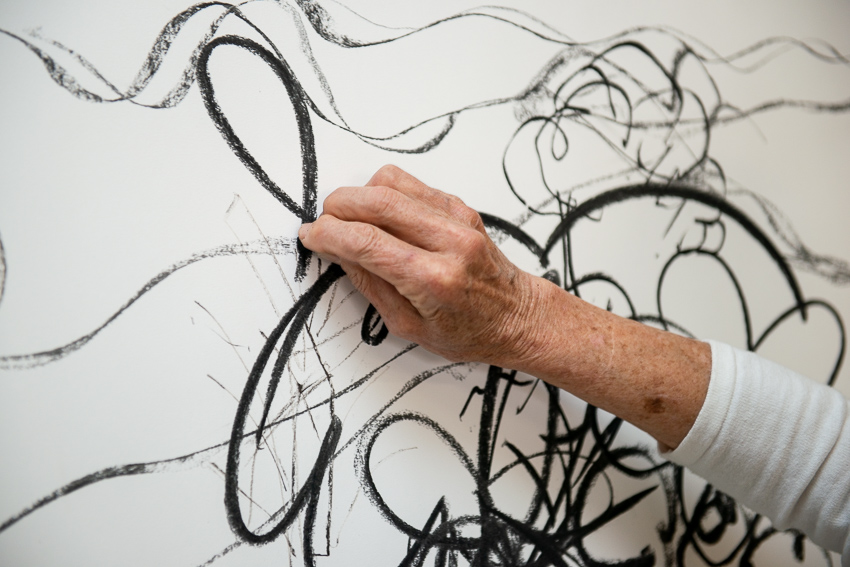By Alex Wisser
Well we’ve begun the journey. KSCA artists Laura Fisher, Jono Bolitho, Georgina Pollard and myself arrived at The Living Classroom to begin our residencies and artworks, engage with the local community and deliver workshops that focused on the role of carbon in the environment and the production of food. I started digging my hole, Georgina began cooking up willow charcoal to be used in the workshops, and Laura and Jono disappeared up North to visit farmers Glenn Morris and Tim Wright and to begin to conceive of the challenging task they had set themselves to visualize the complex world of humus, the key to healthy soil.
The folk at The Living Classroom and Bingara were gracious hosts and the residency was full of social interaction and side adventures. We were even invited to attend a brainstorming event around the new “Pulse of The Earth” festival that the Bingara crew have dreamed up around the public forum that the Artists Farmer and Scientist will host in September of 2019. It’s very exciting that our little project has already inspired an entire festival around the issues we will be exploring.
Our Carbon Science: Carbon Culture workshop was a good gauge of the concern and interest that people in the New England region had for the issues around carbon and climate change. We played to a full house and began with an impromptu session of digging, as it was discovered that our semi-prepared “Kon Ticki” biochar kiln wasn’t correctly shaped. It was brilliant seeing everyone jumping into the hole and working as an impromptu team to quickly shape it to the necessary proportions. After physical labour, we all gathered in the conference room for some sitting and talking and listening.
Environmental scientist Ruy Anaya de la Rosa gave a simple, but useful presentation on the carbon cycle and our effect on it before taking us through some elementary carbon footprint calculations. Having never done this before, the effect was startling - to see the tonnage of co2 emissions that some very basic items of consumption generate was daunting. Alongside it though was the awareness that some very simple shifts in behavior could significantly reduce one’s footprint. I chose to focus on the latter as a way of not being overwhelmed by the former.
The discussion afterward turned very quickly to a consideration of what effect this presentation would have on children (it had originally been devised for schools). The comment was made that children were very aware of climate change and that it was a very scary and emotional subject for them. This was followed by the observation that Climate Change should not be hung on the shoulders of our children - that it is the responsibility of our generation to address it. It reminded me that Climate Change is scary for everyone, and this fear underpins the irrationality of our responses to it. If in our attempts to catalyze action through the loud ringing of alarm bells, all we manage to do is to panic ourselves into further inaction, achieving nothing. The importance of communicating the extremity of our situation needs to be tempered with strategies that cultivate a sense of our own finite agency.
After that rather cheerful beginning, we returned to the Kon Tiki kiln to put some carbon sequestration biochar into action. Ruy and Adam Blakester led us through a demonstration of the Kon Tiki method, which has been described in an earlier post, as we discussed the complexities around the method. Biochar, which is the production of charcoal as a soil amendment, has the capacity to greatly improve water retention, microbial activity, and fertility in soil while locking up carbon for hundreds of years. It also has the capacity to absorb heavy metals and toxins. Biochar is a contested method with its viability at commercial scale still to be established, though there are efforts to develop it on an industrial scale. Ruy and Adam are winding up Biochar for Sustainable Soils (B4SS), a ambitious project introducing biochar to small landhold farming communities in six countries as an affordable method for improving soil and fertility through charring farming waste biomass.
Biochar is perhaps contentious because it is counterintuitive. How are we going to reduce our carbon output by burning more fuel? The argument goes that burning of biomass is carbon neutral. It is only capable of releasing as much carbon as was originally taken out of the atmosphere in the growth of the plant. Through biochar, a considerable proportion of that carbon is locked away. The Kon Tiki kiln, for instance, locks 50% of the carbon contained in its biomass fuel, but there are far more efficient kilns, especially those being developed for industrial scale uses. We were also treated to the use of a drum kiln by Peter Turnbull.
After biochar, we had some lovely lunch and then returned to the classroom to put the charcoal to a different use. KSCA artist Georgina Pollard led the group through a series of process driven drawing exercises, using charcoal produced in the biochar kilns. The exercises were based on children’s party games like pin the tail on the donkey and musical chairs which Georgina had adapted to create collective drawings that emphasized the disruption of individual agency or control over the finished product. The games eliminate or frustrate our tendencies to produce coherent, rational images by constantly removing either sensory or conceptual capacities usually employed in mark making.
The resulting works were ranging, anarchic fields full of brilliant accidents and awkward compositional relationships that ‘cohered’ if at all as broken fields of diversity. Differences in style, skill, or concept collide and communicate, creating fascinating ‘moments’ or thoughts that would have been impossible in a more unified process. What the drawings seemed to manifest was the capacity of the process to exceed those controls we impose when we think about what we are doing, when we conceive, plan and execute in a structured and intentional way. What I recognized amongst the scrawled cacophony of carbon were points of impact that produced something new, something unthought of: intelligent accidents, elegant accidents, insights gleaned through the gaps of logic. While the exercise was not intended to produce a ‘resolved’ work, it gave the participants an experience of a kind of thinking that artists are quite familiar with, and made evident the collective or social nature of this thinking. I wondered what solutions we might arrive at, if this kind of thinking could be brought to bear on the issues we are dealing with at this day.
After the event, Georgie confided in me one regret I cannot help but communicate. She wished that the workshop would have lasted for an entire day, running the exercises again and again so that the artists would push past the initial fun of the games and come to that point at which they would be seriously drawing, absorbed and committed to the pursuit of those processes she had set in motion. Next time.
We ended the day with Rick Hutton presenting on the exciting progress of The Living Classroom from a clapped out paddock to the very impressive regenerative farming and educational facility we had enjoyed on the day. This was followed by Garry McDouall presenting on The Carbon Farm project, a 100 hectare site next to The Living Classroom that will be used to demonstrate and test various methods for sequestering carbon in soil. The presentation was a perfect bookend, given the challenge thrown at the beginning of the day with Ruy’s tally of the carbon costs of our daily lives, Garry talked us through the increasingly powerful ways that plants, through photosynthesis, can pull carbon from the atmosphere and convert it into sugars that are transmitted into the ground to be processed and sequestered by the microbial life within it.
Thanks to Justin Hewitson for making this wonderful video about the workshop:




















